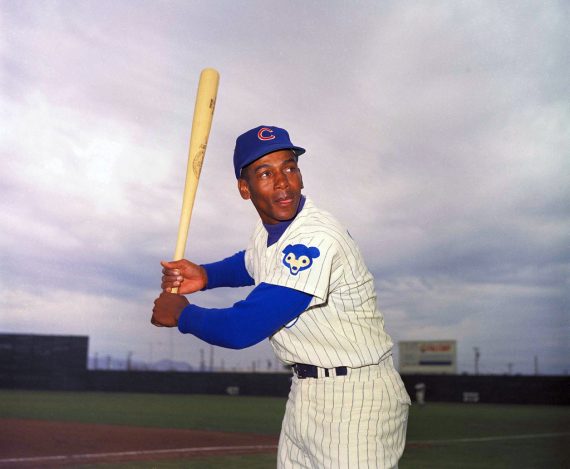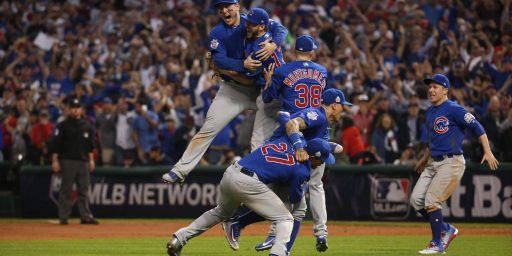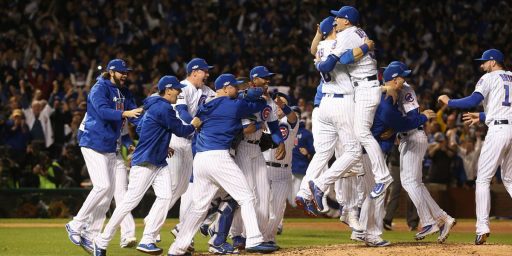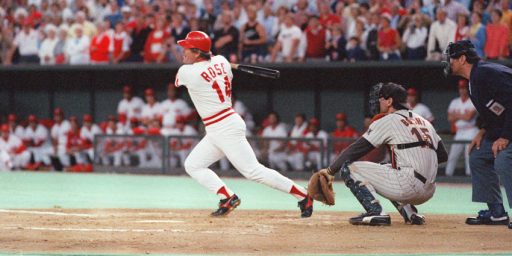Ernie Banks, MLB Hall Of Famer And “Mr. Cub,” Dies At 83
Ernie Banks, who spent all of his 19 Major League seasons with the Chicago Cubs and became a joyous Ambassador for baseball itself in retirement, has died at the age of 83:
Ernie Banks, the greatest power-hitting shortstop of the 20th century and an unconquerable optimist whose sunny disposition never dimmed in 19 seasons with the perennially stumbling Chicago Cubs, died Friday. He was 83.
His death was announced on Major League Baseball’s website, which did not give a cause.
“It’s a beautiful day, let’s play two” became the mantra of the man known as Mr. Cub, a fixture in what he called the friendly confines of Wrigley Field. The most popular Cub ever in a franchise dating to the 1870s, Banks became as much an institution in Chicago as the first Mayor Daley, Studs Terkel, Michael Jordan and George Halas.
Banks cut a slender figure at the plate in his right-handed stance, at 6 feet 1 and 180 pounds, but he whipped a light bat with powerful wrists, hitting 512 home runs. He was named the most valuable player in the National League in 1958 and 1959, the first to win the award in consecutive years, although the Cubs finished tied for fifth place each time. He was an All-Star in 11 seasons and was elected to the Hall of Fame in 1977, his first year of eligibility.
Banks became the Cubs’ first black player on Sept. 17, 1953, six years after Jackie Robinson broke the modern major league color barrier with the Brooklyn Dodgers.
Like Robinson, he had played for the Kansas City Monarchs, one of the Negro leagues’ best-known ball clubs, and when he joined the Cubs, many major league teams were still all white. He was among the first black stars of the modern game, along with Robinson, Roy Campanella and Don Newcombe of the Dodgers, Larry Doby with the Cleveland Indians, Hank Aaron with the Milwaukee Braves and Monte Irvin and then Willie Mays with the New York Giants.
Banks received the Presidential Medal of Freedom, the nation’s highest civilian award, from President Obama in 2013. “I handed the president a bat that belonged to Jackie Robinson,” he told Sports Illustrated the next year. “The president held the bat in his hands — that was a thrill.”
Apart from Banks’s slugging feats, Mr. Obama hailed his “cheer and his optimism and his eternal faith that someday the Cubs would go all the way.”
“And that’s serious belief,” Mr. Obama added, to laughter. “That is something that even a White Sox fan like me can respect.”
Long after retiring, Banks recalled the sweltering midsummer’s day in 1969 when he bubbled over in a phrase that became his trademark.
“We were in first place, and all the reporters were already in the locker room when I arrived at Wrigley for a game with the Cardinals,” Banks told The Arizona Daily Star. “I walked in and said: ‘Boy, it’s a beautiful day. Let’s play two.’ They all thought I was crazy.”
Banks was the ninth player in major league history to hit 500 home runs, and when he retired after the 1971 season, his 293 home runs as a shortstop and his 47 homers in 1958 were career and single-season records for that position, marks eclipsed by Alex Rodriguez. He appeared in 2,528 games for the Cubs, a record for regular-season appearances by a player who never reached the postseason, playing at shortstop until the early 1960s, when he switched to first base because of leg problems.
Each spring, Banks predicted a pennant for the Cubs, who had not won a World Series since 1908 or a National League title since 1945. But each October he was back at home, most painfully in 1969, the year the Cubs experienced one of baseball’s most memorable collapses when they were overtaken by the Miracle Mets. Through all the losing seasons, he exuded an unbridled joy.
“Ernie was the eternal optimist,” the former Cubs second baseman Glenn Beckert told Peter Golenbock in “Wrigleyville” (1996). “Everything is fine, a great day. You’d go back to Chicago from the nice weather in Arizona. A lot of times we’d open against St. Louis, and when you did that, Bob Gibson was going to be their pitcher. Gray, overcast, 32 degrees in Wrigley, big crowd, start snowing about the sixth inning, and Ernie says: ‘Isn’t this a great day? We’ll keep nice and cool so we don’t get overheated.’ ”
Ernest Banks was born in Dallas on Jan. 31, 1931, one of 12 children of Eddie and Essie Banks. His father, a former semipro player in black leagues in Texas, picked cotton and worked as a janitor in a grocery chain. His mother wanted him to become a minister, like one of his grandfathers.
Banks played softball (there was no baseball team) at Booker T. Washington High School in Dallas as well as football, and he competed in track and field. During his high school summers, he toured with a black semipro baseball team, the Colts, based in Amarillo, Tex.
After graduating from high school in 1950, Banks played one season for the Monarchs, then spent two years in the Army, returned to the Monarchs, and was sold to the Cubs in September 1953 for $10,000.
Another black player, Gene Baker, a slick-fielding shortstop, was called up by the Cubs at the same time after spending four seasons with their Los Angeles team in the Pacific Coast League. Banks became the first black player in a Cubs lineup because Baker was injured.
In his major league debut, Banks was 0 for 3 with an error against the Phillies in a 16-4 loss. But three days later, he hit his first major league homer, at Sportsman’s Park in St. Louis, off the Cardinals’ Gerry Staley.
Banks became the Cubs’ regular shortstop in 1954, with Baker installed at second base. He hit 19 home runs that season, then emerged as a star in 1955.
Banks had been using a 34-ounce bat, but toward the end of the 1954 season he switched to a 31-ounce model. That helped him handle outside pitches and enabled him to whip the bat, taking advantage of his strong wrists, which he had developed playing handball.
“Everybody believed you had to have a big piece of lumber and then muscle the ball over the fence,” Banks told The Austin American-Statesman in 1994. “But by the time I, and Hank Aaron, another guy who did it with his wrists, were through, there were a lot of guys ordering light bats and playing handball.”
At a time of civil rights struggles in America, Banks ventured few thoughts beyond the baseball world. In his autobiography, “Mr. Cub,” written with Jim Enright (1971), he commented on the perception that as a celebrity, he should have spoken out.
“Some people feel that because you are black you will never be treated fairly, and that you should voice your opinions, be militant about them,” he wrote. “I don’t feel this way. You can’t convince a fool against his will.”
He added: “I don’t think it’s up to black athletes to get involved in political or racial issues.”
Banks set a major league record for grand slam home runs in a season when he hit five in 1955, and he hit more than 40 home runs five times. He led the National League in home runs and in runs batted in twice. He had 2,583 hits, drove in 1,636 runs and had a career batting average of .274.
He set single-season records for fewest errors (12) and best fielding average by a shortstop (.985) in 1959 and he won a Gold Glove award in 1960, his last full season at shortstop.
Banks was a player-coach in the late 1960s with the Cubs, and after his playing career ended, he spent two years as a full-time coach for the team. He later did part-time promotional work for the Cubs. When the team dropped him from that role in June 1983, saying he had missed some scheduled appearances, there was consternation in the Chicago press. “Cubs Snub Mr. Cub,” one headline read.
But the Cubs had Banks back as an honorary member of their 1984 divisional champions when they were the San Diego Padres in the league championship series — and lost.
Banks also served as a corporate spokesman and founded the Ernie Banks Live Above and Beyond Foundation, which raised money for charities.
He was the first player to have his jersey number retired by the Cubs, and his No. 14 flies from the left-field foul pole at Wrigley Field on game days. A statue depicting Banks in his batting stance was unveiled outside the ballpark in 2008. “Let’s Play Two” is inscribed on its base.
From the Chicago Tribune:
nie Banks, one of baseball’s most ebullient and optimistic ambassadors, died Friday, his wife, Liz, confirmed.
Known worldwide as “Mr. Cub,” Banks became the Cubs’ first African-American player on Sept. 17, 1953, and went on to become an 11-time All-Star and two-time National League Most Valuable Player (1958-59). His boundless enthusiasm and optimism personified what it meant to be a Cubs fan.
Cubs Chairman Tom Ricketts released the following statement Friday night:
“Words cannot express how important Ernie Banks will always be to the Chicago Cubs, the city of Chicago and Major League Baseball. He was one of the greatest players of all time. He was a pioneer in the major leagues. And more importantly, he was the warmest and most sincere person I’ve ever known. Approachable, ever optimistic and kind-hearted, Ernie Banks is and always will be Mr. Cub. My family and I grieve the loss of such a great and good-hearted man, but we look forward to celebrating Ernie’s life in the days ahead.”
Mayor Rahm Emanuel also released a statement in praise of Banks.
“Ernie Banks was more than a baseball player. He was one of Chicago’s greatest ambassadors,” Emanuel said. “He loved this city as much as he loved — and lived for — the game of baseball. This year during every Cubs game, you can bet that No.14 will be watching over his team. And if we’re lucky, it’ll be a beautiful day for not just one ballgame, but two.”
Gov. Bruce Rauner also lauded Banks.
“Ernie Banks was a trail blazer who helped break down barriers, a veteran who served his country with honor, a respected community leader and the greatest Chicago Cub of all time,” he said in a statement. “While we mourn him here, there’s no doubt that up in heaven, ‘Mr. Cub’ is lacing up his cleats and asking Saint Peter if they can ‘play two.’ Ernie Banks’ passion for baseball and for life showed us what true joy looks like and captured our hearts. He inspired us all.”
Banks, who hit 512 home runs and had 1,636 RBIs, was inducted into the Hall of Fame in 1977.
Renowned for his sunny disposition, Banks, 83, loved the game and often proclaimed: “Let’s play two!” even when the Cubs struggled to climb out of the National League basement. On Nov. 20, 2013, Banks was awarded a Presidential Medal of Freedom during ceremonies at the White House in recognition of his goodwill.
When first notified that he would be receiving the award, Banks said: “It means everything to me. It means life is just wonderful. When you do things to try to help people and share things, it really comes back to you. I try to do that. I love the players, love Wrigley Field, love all the players. … This award means a lot to me. It’s almost like the Nobel Peace Prize to me.”
(…)
Banks’ best overall season was 1959 when he led the NL with 143 RBIs and hit 43 home runs. Defensively, he led all shortstops with a .985 fielding percentage. In 1960 he won a Gold Glove at shortstop. He hit more than 40 homers five times, including 47 in 1958. In 1955 he hit a record five grand slams. Banks played his entire career with the Cubs and is considered one of the greatest players of all time not to play in the postseason.
Banks played more games at first base (1,259) than he did at shortstop (1,125), but he is remembered more for his most productive younger seasons at shortstop.
“It was just a pleasure playing with Ernie. I can’t say it was a pleasure playing against him,” said former Cubs pitcher Milt Pappas, who also pitched for the Orioles, Reds and Braves during his 17-year career. “He was so genuine. He was just a great ambassador for the game.”
A statue of Banks’ likeness was unveiled near the corner of Clark and Addison outside of Wrigley Field at the start of the 2008 baseball season.
“When I am not here, this will be here,” Banks joked after the ceremony as he pointed to the sculpture.
And if it’s a beautiful day, maybe they’ll play two.







I just posted a story about my own personal memory about the late, great Ernie Banks and his 500th home run on my blog.
Click here to read it: https://ednovick.wordpress.com/…/…/24/mr-cub-made-an-impact/
Incredibly there are 4 players from those perennial losing Cubs teams in the HOF
Absolutely my favorite player when I was 7, living in southern Illinois. He was already past his prime then, playing first base, but he was still the soul of the team.
I hadn’t realized he was the first African-American signed by the Cubs. That’s sad, but it also makes it mean that much more that he was “Mr. Cub” to everyone long before his career was over.
So the StinkBird fans ran you out of paradise?
@ernieyeball:
Grandpa was a Cubs fan; Grandma was a Cardinals fan. (Both adored Harry Carey, of course.) They used to sit at opposite ends of the house to listed to Cubs-Cardinals games on the radio.
I’m fickle. I rooted wildly for the Cardinals from about 1980 to 1989, though I was living in the East by then. When I moved to Pittsburgh, I was converted, and rooted for the Pirates from 1990 to 1995, during the Bonds/Bonilla/Drabek years of almost. Now I live in DC, and root for the Nats and Orioles. (I lived in Baltimore about 10 blocks from Memorial Stadium from ’80 to ’84, so it’s not entirely unreasonable…)
My Grandpa was 21 in 1908 when the Cubs won their last World Series. There was no radio then. He had to read about it in the paper!